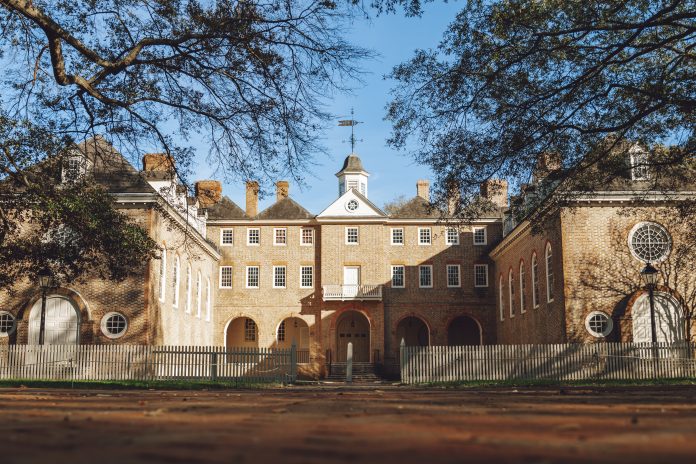After receiving both federal and state grants, the College of William and Mary is set to renovate the Sir Christopher Wren Building for preservation.
Beginning in December, this project will result in the installation of scaffolding and temporary fencing surrounding the College’s most historic building.
The Director of Wren Operations and Events Charles Fulcher ’99 explained the collaboration and effort involved in applying for the grants necessary for the preservation of the Wren Building.
“The process of applying for a federal grant like this is really an interdisciplinary collaboration, pulling together voices from historic campus, facilities and the Office of Sponsored Programs, who helps shepherd all such grant projects across the university,” Fulcher wrote in an email to The Flat Hat.
Fulcher further noted the necessity of the project. In a presentation given to the Student Assembly, he explained that an envelope study of Wren Building found that it is experiencing draining and flooding issues, causing leaks and rotting. The building’s bricks also are aging and in need of protection and patching.
“We’re preserving the building, making necessary repairs and improvements to keep it standing and thriving for the future. You look at the Wren and you can see signs of its age,” Fulcher wrote.
The Wren Building’s last big project occurred over 20 years ago and focused on making the structure more comfortable for student and faculty use. Fulcher noted this project focused less on repairing the actual building.
“The last big project, called the ‘Wrenewal,’ was over 20 years ago; it lasted from 1999 to 2001. While that project included some repairs, it largely worked on electrical, plumbing, and HVAC in the building, along with converting the use of several interior spaces,” Fulcher added. “During the Wrenewal, the Wren was closed for daily use — something we knew from day one we wanted to avoid during the upcoming preservation project.”
The College’s Associate Vice President for Business Affairs Sean Hughes oversees the physical campus and all services that support the physical campus. When asked about the usability of the Wren Building during construction, he noted the interior will be almost the same as it was before construction.
“There will be construction fences around the building, but the entrances will be open, protected and the same width and functionality as they have always had,” Hughes wrote in an email to The Flat Hat.
Fulcher remarked that while the building will remain operational, the outside will have an altered appearence.
“The environment will admittedly look a little different: scaffolding around the structure, overhead protection at entrances for safety, fencing that will line many of the sidewalks around the building,” Fulcher said.
While it is clear these upgrades are necessary to preserve the nation’s oldest-standing college building, some seniors are concerned about what the traditions they have been awaiting, like Commencement to graduation photos, will look like amidst all the construction.
Although senior activities in the spring will admittedly not have the same aesthetic they usually do, Hughes conceded that Student Transition Engagement Programs will be helping graduating students expedite some of their plans, like taking senior photos, to occur before the construction begins.
Fulcher shared the College’s intentions to distribute senior regalia early to accommodate the move.
“Student Affairs is finalizing a plan offering regalia for graduating students to reserve for photos around the Wren before the project starts. We’re hoping to begin offering that this month after Homecoming. We’re planning to have the same regalia available for Senior Headshots in the Wren’s Great Hall in mid-November,” Fulcher told WMNews.
Still, to many seniors, this advancement will not make up for the graduation experience they have been waiting for since their freshman years.
Ali Espino ’25 was excited to take her graduation photos in front of the building and expressed disappointment about being unable to share in this tradition for seniors.
“It’s not going to be what I’ve been looking forward to all four years. So that really puts a sort of a damper on my senior year,” Espino said.
Phil Brooks ’25 shared a similar feeling. He explained that a huge reason he chose to come to the College was because of the beautiful historic campus, and he was saddened that he would not be able to enjoy the main attraction of the campus during his final semester here.
While both seniors understand the necessity of the preservation project, they both admitted they were caught off guard by the administration’s decision to do so.
Espino was lucky enough to learn of the project earlier on from some of her friends who work for Student Assembly. However, she expressed her concern about the fact that the remainder of students are only learning about this now, and she wishes the administration allowed for student input on the project.
“Not many people know about this, and you kind of only know if you hear it from somebody who somehow knows. It would have been much better to hear it from the school and maybe have some input in it. It feels like we weren’t even told this thing was happening, and now it’s happening, and there’s really nothing we can do about it,” Espino said.
Brooks only learned about the preservation when asked to comment on it.
“Yeah, I wish that they had been a little clearer on the timing. I wish they had been a little clearer about, you know, actually doing it. The fact that this exists has been very unclear. And I think mainly clarity is the biggest issue, obviously, sometimes restorations are necessary,” Brooks said.

